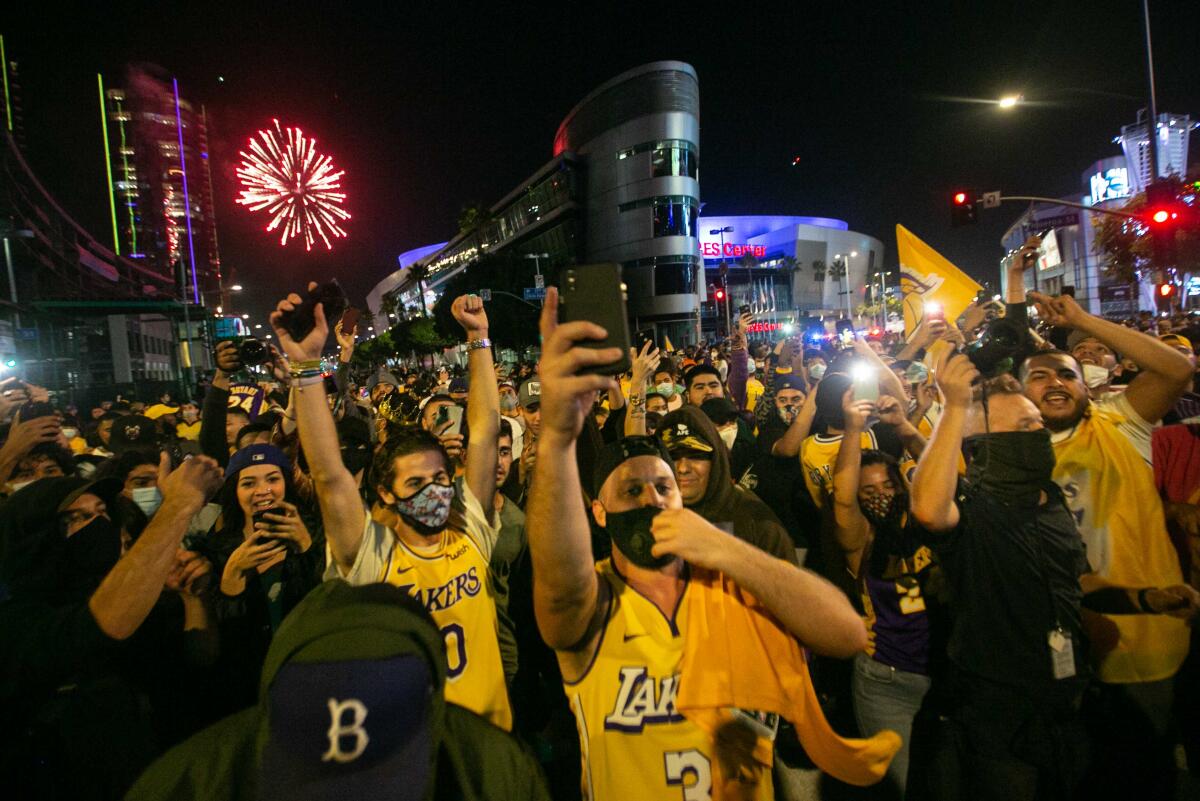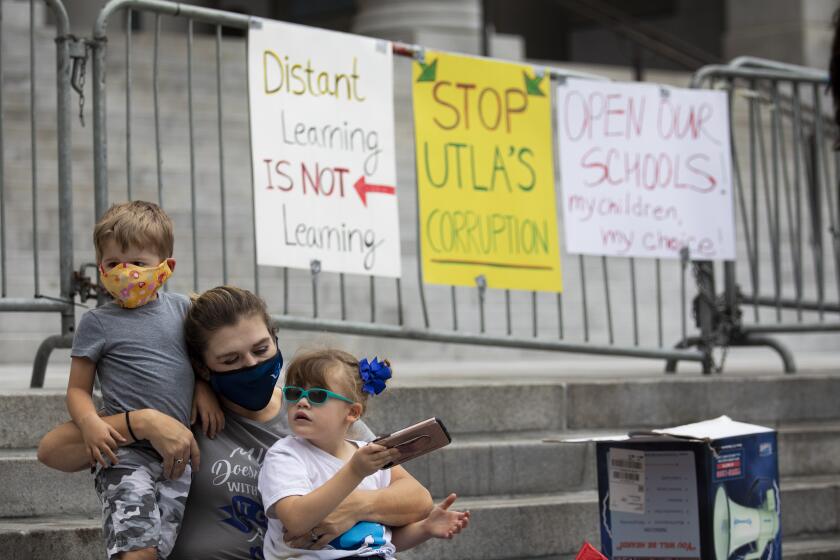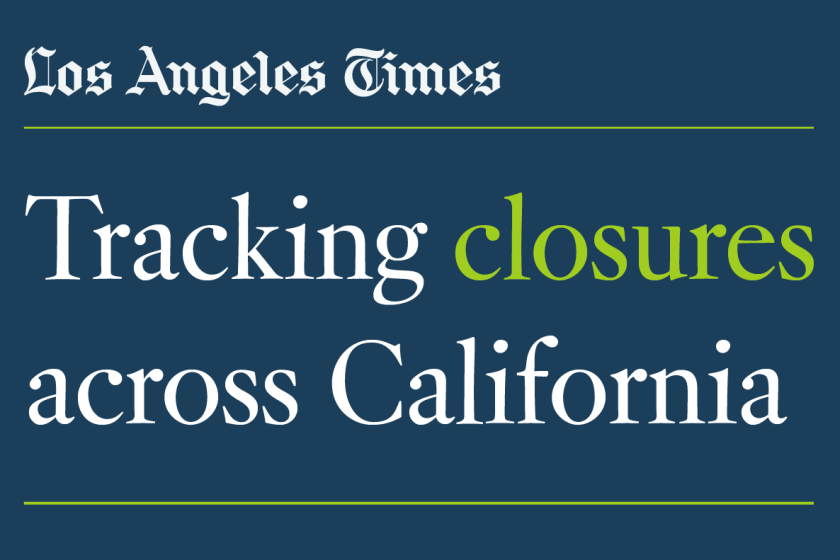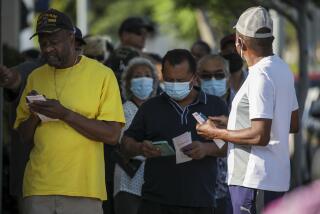As Dodgers and Lakers win, coronavirus spreads at celebrations, alarming health officials

Southern California counties are reopening their economies at a slower pace than other parts of the state, and officials blame celebrations. Lakers and Dodgers viewing parties and public events are keeping coronavirus infections high enough to hold the region back, officials warn.
California has avoided the substantial spike in coronavirus cases seen across the country this fall, but some of the state’s most populated counties — Los Angeles, Riverside and San Bernardino — remain in the most restrictive reopening tier.
That means indoor dining rooms are shut, as are indoor operations of gyms and houses of worship. San Diego County, now in the red tier, is teetering on backsliding into the most restrictive category.
Public health officials have identified gatherings as a significant source of virus transmission in Southern California, where young adults are driving the spread of the highly contagious disease.
There are also troubling signs of a potential increase in coronavirus cases. Even after accounting for a backlog, Los Angeles County has gone from about 940 daily new cases at the beginning of October to nearly 1,200 new cases each day as of last week, based on the date of a positive test or the first onset of symptoms, said Barbara Ferrer, the county’s director of public health.
Los Angeles County surpassed 300,000 confirmed coronavirus cases and reported its 7,000th death Monday, health officials said.
Officials are worried that the post-season success of the Lakers and the Dodgers may be playing a role in the increased coronavirus cases.
“Gatherings in large crowds to watch games indoors, people aren’t wearing their face coverings, people are yelling a lot — that’s just not sensible,” Ferrer said.
Even congregating at outdoor restaurants, while shouting and cheering and hugging strangers without wearing masks, makes it “so easy to spread this virus,” she said.
About 55% of people who knew of a possible exposure to the virus also attended a gathering where two or more people were sick, the county said, based on interviews with the newly infected or people who were in contact with them over the last three weeks.
Other parts of Southern California are seeing similar trends.
“We’re seeing more spread at family and friend gatherings,” said Corwin Porter, public health director for San Bernardino County. “It seems to be more prominent in our younger populations — our under-40 crowd, for the most part.”
Among newly infected people who said they attended some kind of large gathering in the previous month in San Bernardino County, 61% attended gatherings of friends or family, according to data from the second full week of October.
In Riverside County, public health officer Dr. Cameron Kaiser expressed dismay about a crowd of more than 1,000 people who showed up at the Banning Street Drag Race at the Banning Municipal Airport — a mass gathering that has the potential of becoming a superspreader event. Mass gatherings are generally banned under the state’s public health order.
“The more people you get into a place, then the higher the risk that someone is going to be there with a big load of virus,” Kaiser said. “Paradoxically, it’s probably somebody healthier because they can tolerate it. And then those people turn out to be highly efficient in giving it to other folks.”
Gatherings take on an outsized importance, Kaiser said, with research showing that superspreader events are responsible for the majority of new infections. Some people can infect others without ever falling sick themselves; others can be contagious for 48 hours before showing symptoms.
“We deal with underground parties and house bashes on a regular basis,” Kaiser said. “Sometimes you don’t hear about these on social media until it’s too late.”
Neighborhoods around universities remain a persistent problem. An outbreak has been identified among residents of student housing at Chapman University in Orange County. Since late August, more than 1,200 students at San Diego State University have tested positive for the coronavirus.
Large parties among families and friends at private homes are also a problem, with hosts even renting inflatable bounce houses.
“We’re talking about multiple families getting together at residences, having even Jolly Jumps up on the front yard or in the backyard; multiple cars lined up in the street. We’ve even had reports of actual live music bands in residences,” said Rigoberto Vargas, director of public health for Ventura County.
Officials have resorted to pleading with the public to take the worst global pandemic in a century more seriously.
“People are lowering their guards — going back to how they functioned before COVID-19, going to gatherings,” said San Diego County public health officer Dr. Wilma Wooten.
San Diego County is at risk of being forced by the state to close indoor dining rooms and indoor gyms and houses of worship if the transmission rate increases.
Gatherings are one of several reasons why Southern California remains stuck in a coronavirus limbo, experts say.
Transmission is likely occurring at workplaces where employees are closer together. And transmission may be greater in rural agricultural communities where migrant workers live in dense housing arrangements, as well as urban areas where low-income workers live in crowded homes and are less likely to be able to telecommute, said Dr. Robert Kim-Farley, medical epidemiologist and infectious diseases expert at the UCLA Fielding School of Public Health.
Long before the pandemic, the Centers for Disease Control and Prevention identified Los Angeles, Riverside and San Bernardino counties, as well as many counties in the Central Valley, Salinas Valley and Imperial Valley, as ranking worse on a social vulnerability index. That means that factors such as poverty, a lack of access to transportation and crowded housing may weaken a community’s ability to prevent human suffering and financial loss in a disaster.
L.A. County faces special challenges as a diverse and populous county, with some of the most crowded census tracts in the nation, and with its sheer size of more than 10 million residents, Ferrer said. Those things can make it challenging to manage a complicated reopening strategy.
The county also has a fairly high rate of poverty and a large number of Latino residents, communities that have been hit disproportionately hard by the virus.
There are also political factors. In some parts of Southern California, there has been an explicit rejection of mask use, Kim-Farley said. In Huntington Beach, workers say they have had their fair share of customers refusing to wear masks, with some even tearing down signs promoting their use.
To contain the spread of COVID-19, parks, restaurants and stores are slowly reopening.
Unlike Southern California, the Bay Area has achieved vastly different results. Some contributing factors may be the differing response of local leaders and public sentiment.
Some Southern California politicians have been among those pushing the state to more rapidly loosen restrictions on businesses. By contrast, many health officials in the Bay Area have taken a decidedly slower approach, often retaining more restrictive rules even after state officials loosen them.
In San Francisco, Mayor London Breed credited residents for driving down the spread of the disease.
“I know they were tired of me, over and over, pretty much yelling at everyone and asking people to wear your mask, socially distance, cancel your events, don’t come together,” Breed told a local TV station. “The fact is: People actually listened.”
San Francisco is now in the state’s yellow tier, thanks in part to decreasing the disproportionate impact of the virus on the city’s most disadvantaged neighborhoods, state officials said. The yellow tier is the state’s least restrictive on its four-part color-coded reopening plan, allowing wide swaths of businesses to resume operations.
Some experts have also speculated that people in the Bay Area tend to adhere to health rules more than in other places.
The area’s poorly performing sports teams may have also assisted earlier this year when the pandemic first struck the region. Epidemiologists credited the San Francisco 49ers’ loss at the Super Bowl — and the resulting failure to have a victory parade — as a big reason why the Bay Area may have escaped a worse first wave of the pandemic in the spring.
State officials announced last week they will devote more resources to Los Angeles, Riverside and San Bernardino counties, including increasing mobile testing and helping those infected to isolate themselves while they recover. They said similar strategies helped tamp down a surge in the Central Valley earlier this year.
Health officials are worried that Thanksgiving and Christmas could transform into superspreader events if people don’t cancel large gatherings or, at a minimum, take precautions. New state minimum requirements allow for only small outside gatherings of no more than three households, keeping guests six feet apart, wearing masks when not eating or drinking, serving food in single-serve disposable containers and limiting events to no more than two hours.
Times staff writers Luke Money, Maura Dolan and Stephanie Lai contributed to this report.
More to Read
Sign up for Essential California
The most important California stories and recommendations in your inbox every morning.
You may occasionally receive promotional content from the Los Angeles Times.














